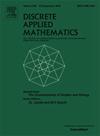母源图在线性时间内特征值的定位
IF 1
3区 数学
Q3 MATHEMATICS, APPLIED
引用次数: 0
摘要
利用由Tyshkevich引起的分解,我们证明了母系图的团宽度最多为4,这使我们能够在线性时间内计算这些图的子族的一些谱参数,如谱半径和代数连通性。这是使用M. f本文章由计算机程序翻译,如有差异,请以英文原文为准。
Locating eigenvalues of matrogenic graphs in linear time
Using a decomposition due to Tyshkevich, we proved that matrogenic graphs have clique-width at most 4 and this allowed us to compute, in linear time, some of spectral parameters, such as the spectral radius and the algebraic connectivity, for subfamilies of these graphs. This was achieved using the Diagonalize Algorithm developed by M. Fürer et al. in 2019. The techniques applied here may provide valuable tools to further explore spectral properties of matrogenic graphs and related graph classes as well.
求助全文
通过发布文献求助,成功后即可免费获取论文全文。
去求助
来源期刊

Discrete Applied Mathematics
数学-应用数学
CiteScore
2.30
自引率
9.10%
发文量
422
审稿时长
4.5 months
期刊介绍:
The aim of Discrete Applied Mathematics is to bring together research papers in different areas of algorithmic and applicable discrete mathematics as well as applications of combinatorial mathematics to informatics and various areas of science and technology. Contributions presented to the journal can be research papers, short notes, surveys, and possibly research problems. The "Communications" section will be devoted to the fastest possible publication of recent research results that are checked and recommended for publication by a member of the Editorial Board. The journal will also publish a limited number of book announcements as well as proceedings of conferences. These proceedings will be fully refereed and adhere to the normal standards of the journal.
Potential authors are advised to view the journal and the open calls-for-papers of special issues before submitting their manuscripts. Only high-quality, original work that is within the scope of the journal or the targeted special issue will be considered.
 求助内容:
求助内容: 应助结果提醒方式:
应助结果提醒方式:


